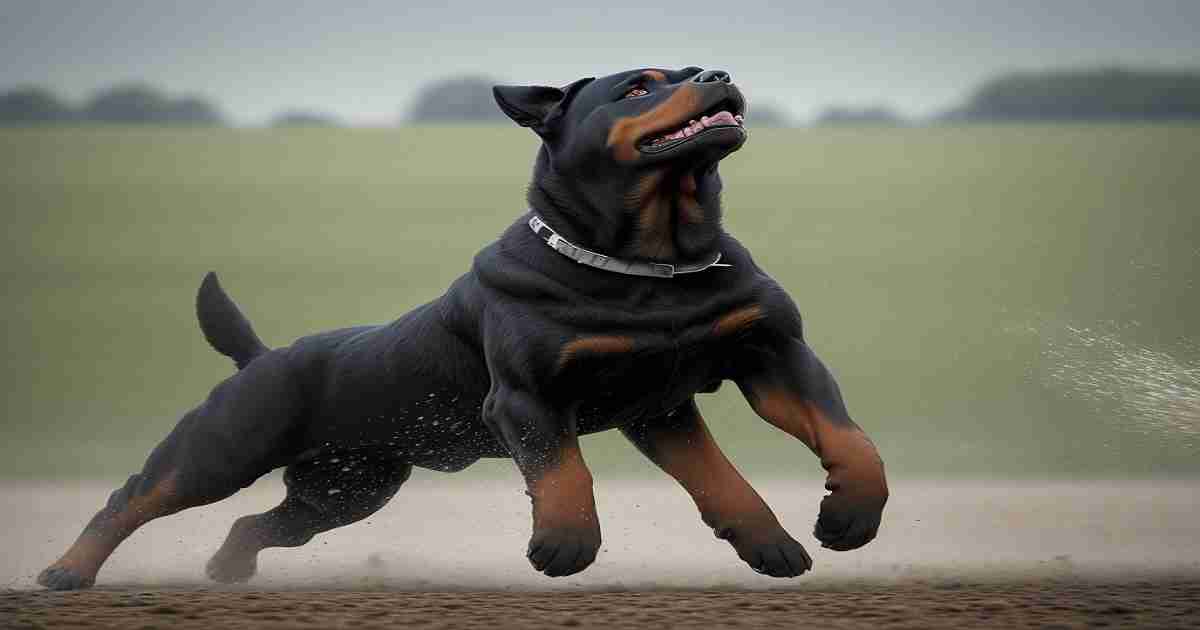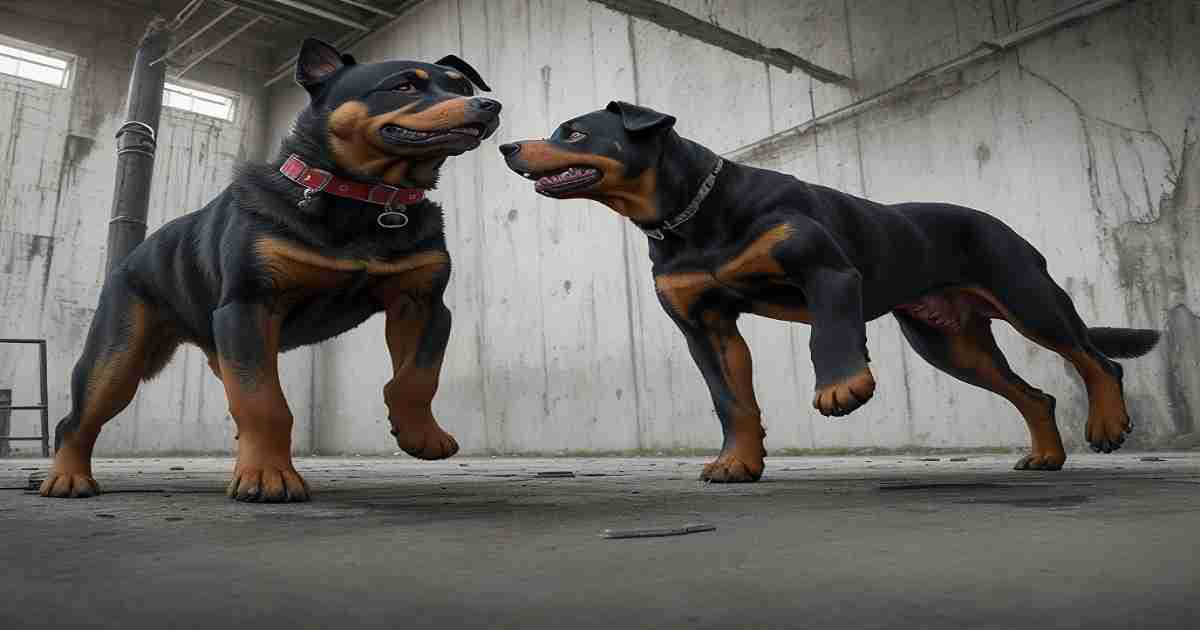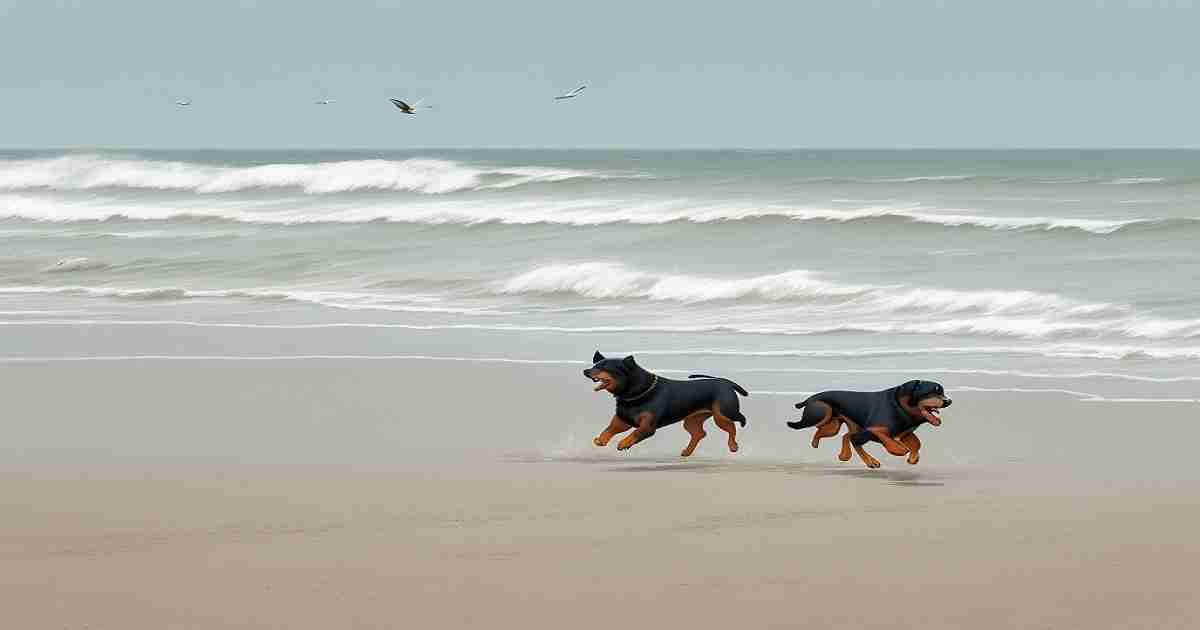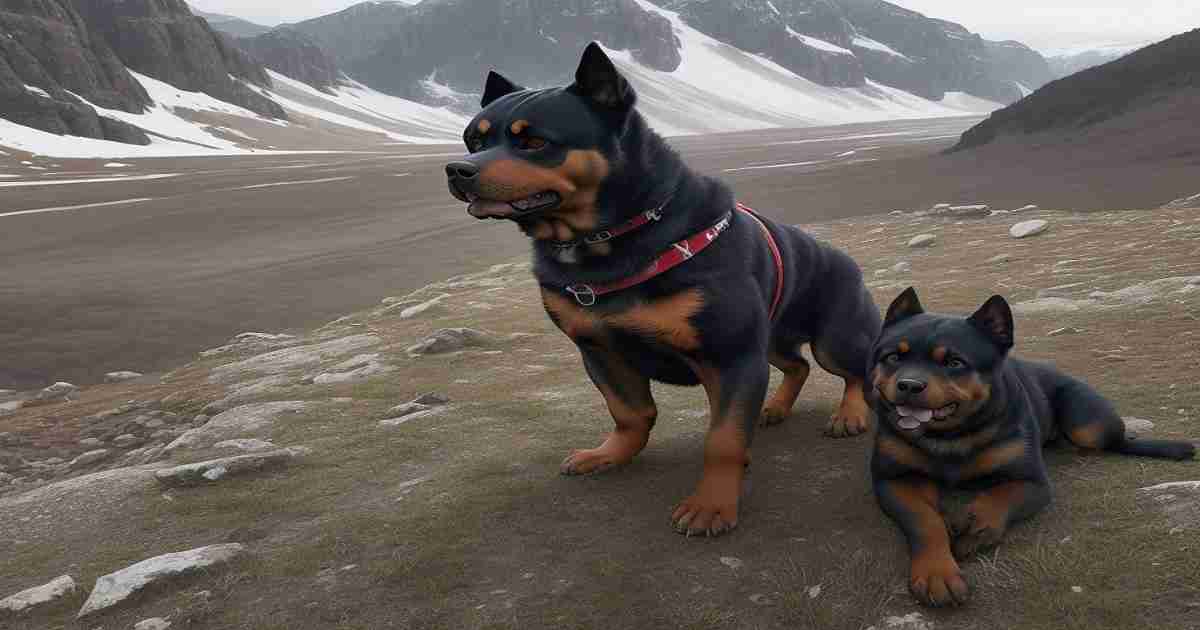Listen, I get it. You adopted your Rottweiler hoping for a loyal companion to share your life with. Someone to cuddle up on the couch with and take on fun walks and adventures.
But now, your perfect pooch has started growling when you reach in for a pet or scratch behind the ears. Yikes!
Suddenly your cuddle buddy turns into Cujo with a simple pat on the head. Not exactly the bonding experience you imagined.
If your Rottweiler has started giving you the cold shoulder (or shall I say cold growl), don’t panic.
With some detective work and training, you can get to the bottom of the behavior. Then show your pup that pets and scratches equal good things, not grumpy growls!
This tail’s for you if your Rottie’s growling has you worried and confused. Today we’ll chat about:
- Common reasons behind the grouchy growling
- Clues your body language is sending
- Smart training to curb the behavior
- When to call in the pros for help
Grab some treats and let’s get to the bottom of the growling mystery!
Why Your Rottweiler Growling When Petted
Rottweilers are complex dogs, known for their loyalty as much as their stubbornness. So dive into that handsome head of theirs to uncover what’s driving the growling response.
Here are some of the most common culprits behind Rottweiler growling when petted:
Territorial Tendencies
Rottweilers take their role as protector very seriously. It’s ingrained in their breed history as guardians of livestock.
Unfortunately, sometimes that protectiveness goes overboard and turns into resource guarding. And yes, that includes guarding their own personal space and bodies.
When you reach in to pet a territorial Rottweiler, they see it as an invasion of their space. The growling is their way of saying “back off!” to ward you away.
Dominance Issues
Sure, Rotties are total softies at heart. But they can have a stubborn streak too.
Some Rottweilers will test boundaries and try to assume the alpha role. Growling when you pet them can be their way of exerting dominance over you.
They’re reminding you who the “boss” is by making you back down when they growl. Not a great habit!
Fear and Poor Socialization
Don’t assume all growling stems from aggression. Sometimes it’s fear-based.
Puppies that don’t get properly socialized can become hand-shy or anxious about human touch. Reaching toward a sensitive Rottie may elicit a fearful growl.
Past trauma like abuse can also make a Rottweiler extra skittish. Growling is their misguided attempt to say “please don’t hurt me.”
Pain or Illness
Dogs aren’t great at directly telling us when they’re hurt or sick. So unexplained growling when touched warrants a trip to the vet.
Arthritis, ear infections, dental issues or injuries can all cause pain that leads to growling when handled. Better safe than sorry if this behavior seems out of character.
Genetics and Early Experiences
A dog’s unique personality and tendencies are shaped by more than just their breed.
Early life experiences in the litter can influence temperament – for better or worse. And some dogs are naturally more anxious or reactive than others, even with great socialization.
Figuring out the “why” behind your Rottweiler’s growling tendencies takes some detective work. But once you pinpoint the root cause, you can start addressing it with targeted training tactics. More on that in a bit!
First, let’s cover how to “speak dog” and read your Rottweiler’s body language when you reach in to pet them. Their subtle signals can reveal a lot about what’s going on in your pup’s head.
Reading Your Rottweiler’s Body Language
Dogs may be man’s best friend, but we don’t exactly speak the same language. While your Rottweiler can’t tell you why they’re growling in plain English, their body language and signals can fill you in.
Here are some of the behaviors to look out for next time you go in for a pet or scratch:
- Tense muscles: Watch how your dog’s body reacts as you reach your hand toward them. Do their muscles tighten up? Are their ears pinned back? A tense posture screams discomfort.
- Lip curls: Some dogs give subtle “warning growls” where their lips pull back slightly before audible growling starts. It’s easy to miss, so watch closely.
- Yawning: While totally normal at times, repeated yawning when being petted can signal stress. It’s another warning sign worth addressing.
- Whale eye: This is when you can see the whites of your dog’s eyes because they’re looking at you from the corner. Whale eye says they’re feeling nervous or threatened.
- Paw lift: Raising their paw toward you can signal irritation or guarding behavior when touched. They may eventually progress to snapping when uncomfortable.
- Leaning away: Does your dog subtly lean their body away when petted? Distance increasing shows they don’t fully trust the situation.
- Freezing up: Some anxious pups may suddenly freeze when you reach to pet them. They want no part of the interaction.
These are just a few examples of body language cues to watch for. There are many subtle signs our pups use to communicate their discomfort or warnings before resorting to growling.
Knowing these doggy hints helps you intervene and address the issue before it escalates.
Now, say you’ve noticed a few of these signals popping up when you go to pet your Rottweiler. What steps should you take next to start correcting the behavior?
Training Techniques to Curb Your Rottweiler’s Growling Response
Patience and proper training is key to reversing your Rottweiler’s habit of growling during pets. While it may take time, you can help them see touches and handling as positive experiences again.
Here are my top training tips to curb growling when petted:
Countercondition Touching and Handling
Counterconditioning is a super helpful training method for behavior issues like this. The idea is to change your dog’s emotional response to something by associating it with good things.
So for example, every time you go to pet your Rottweiler, immediately give them a high value treat afterwards like a small piece of chicken. Or use easy cheese or peanut butter on a spoon for an extra yummy pairing.
By repeating this pairing over and over, you teach your dog that good things happen when humans reach toward them.
You’re counteracting that previous negative response of growling and replacing it with “oh boy, pets mean chicken!” Positive reinforcement for the win!
Use Desensitization Techniques
Along with counterconditioning, you want to use desensitization to an overload of touching and handling.
This means starting with very small, gentle pets in spots your dog finds less threatening, like under their chin or on the chest. Keep sessions brief and reward them, then end on a positive note.
Gradually work up to longer petting sessions, more sensitive areas like the belly or ears, and various types of touch like gentle scratches or massages. But always let your dog dictate the pace. Push too fast and you’ll undo your progress.
The goal is to very slowly rebuild their comfort level with human handling through positive experiences. It’s a marathon, not a sprint so be patient!
Practice Hand Targeting
Teaching your Rottweiler to touch their nose to your open palm on command builds trust and confidence. It’s less threatening for them to choose to initiate touch versus you reaching for them.
Hold your palm out and say “touch” then reward when they boop your hand with their snoot. Keep sessions short and upbeat.
Over time, work up to moving your hand gradually closer to their head and ears. Reward generously for working through their discomfort!
Use the “Look” Cue
The “look” command is another great way to build focus on you versus fixating on your approaching hand.
Right before you reach out to pet your dog, say “look!” When they make eye contact, reward instantly with a treat.
This helps shift their attention to your eyes versus obsessing over your hand as a threat. It also reinforces that paying attention to you is a positive thing.
Limit Petting to Consenting Dogs
This one may seem obvious, but it’s worth emphasizing: only pet your dog when they’re clearly comfortable with it.
Watch your Rottweiler for those whale eye, tense muscles, lip curls we covered earlier. If they look uneasy in any way, don’t push it. Let them initiate affection on their own terms.
Repeatedly pressing on when your dog looks squirmy trains them petting is a bad thing they should avoid. Instead, doubling down on rewarding consent builds confidence.
So there you have it – five solid training tips to help reverse your Rottweiler’s growling response and renew their trust in being touched. But it does require work and patience on your part. Which leads me to my next point…
Getting Professional Help for Serious Cases
For minor growling issues, the average pet owner can implement counterconditioning and positive reinforcement training at home to rewire the behavior. Hooray!
But for more entrenched cases where growling progresses to snapping or biting, bringing in the professionals is your smartest (and safest) bet.
Here are some good indicators it’s time to get expert help with your growling Rottweiler:
- You’ve followed training protocols for weeks with no improvement.
- The growling escalates quickly to lunging or snapping when touched.
- Your Rottie is actively resisting handling by you or family members.
- You can’t pinpoint the root cause of your dog’s behavior.
- Your attempts to correct the growling seem to make it worse.
- You don’t feel fully safe or confident handling the dog on your own.
The right certified trainer or behaviorist can help accurately diagnose the cause of your Rottweiler’s aggressive responses. Then they’ll design a customized training plan using proven techniques like counterconditioning, desensitization, and positive reinforcement.
For issues stemming from dominance, they can also teach you the proper ways to establish strong leadership and encourage respectful behavior.
Investing in an expert sets you and your Rottie up for success. It keeps both of you safe in the process. And helps strengthen that bond you’re aiming for.
When Growling Indicates a Serious Medical Issue
So far we’ve focused on preventable causes of Rottweiler growling like poor socialization or dominance challenges. But in some cases, aggression when touched points to an underlying medical problem.
Signs that warrant an immediate vet visit include:
- Sudden unexplained growling when your dog was previously gentle
- Growling or reacting when touched in a specific area of their body
- Other unusual behavior changes like appetite loss, lethargy, or restlessness
- Unprovoked aggressive incidents apart from when you reach to pet them
- Age 7+ and the growling is a new development
- No history of abuse or poor socialization to explain the behavior
Dogs aren’t great communicators when it comes to pain. So your Rottweiler snapping when touched around their hips or neck might be their only way of saying “ouch, that hurts!”
Conditions that can elicit pain responses when handled include:
- Arthritis or joint issues
- Dental problems like abscesses or fractured teeth
- Ear or skin infections
- Internal issues like organ disease or cancer
- Injuries or surgical sites that are sore
If an underlying physical cause is suspected, your vet will recommend appropriate diagnostic testing. Things like blood work, x-rays, an exam under sedation, biopsy of lumps, etc.
Getting to the root of the pain can allow targeted treatment to relieve their discomfort. Then your Rottweiler can go back to enjoying pets pain-free!
So in summary, never ignore or punish sudden aggressive behavior in your senior dog or a previously gentle Rottweiler. It can be the first sign of serious illness. Speak up for your dog and take them to the vet if your gut says something is off.
The Key Is Patience, Consistency, and Compassion
I’ll wrap up this novel with a gentle reminder – rehabilitating a growling dog requires much more patience and compassion than frustration or punishment.
Trust me, I know your dog’s behavior can be incredibly frustrating and even scary at times. Especially when you fear getting bitten.
But meeting growling with anger or scolding will only teach your Rottweiler to distrust humans even more. It’s counterproductive.
Instead, make an effort to see the growling through your dog’s eyes. To them, this behavior likely stems from feeling threatened, insecure, or pained in some way.
So be the one willing to rebuild their confidence through positive experiences. Shower them with tasty treats, favorite toys, and genuine praise for any step in the right direction – no matter how small.
With time, the right training approach, and maybe some professional guidance, you can help your Rottweiler unlearn those negative associations. Until petting and handling become a joy again, not something to growl about.
If you stay patient and nurture the amazing relationship dogs and humans can share, this bump in the road will just be a faint memory.
Your loyal Rottie is counting on you to help them be their best furry self. And that special bond you share makes every obstacle worth working through.
So take a deep breath, grab those training treats, and get ready to rebuild your dog’s trust through positivity. You’ve got this! And I’m wagging my tail cheering you both on.
Let me know if you have any other questions for overcoming Rottweiler growling issues on your journey together. I’m always happy to chat dogs!









